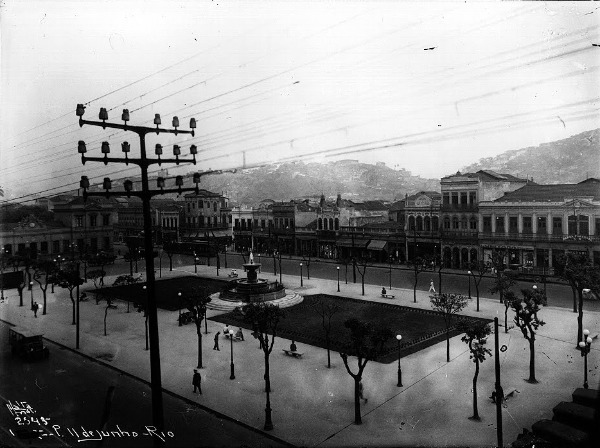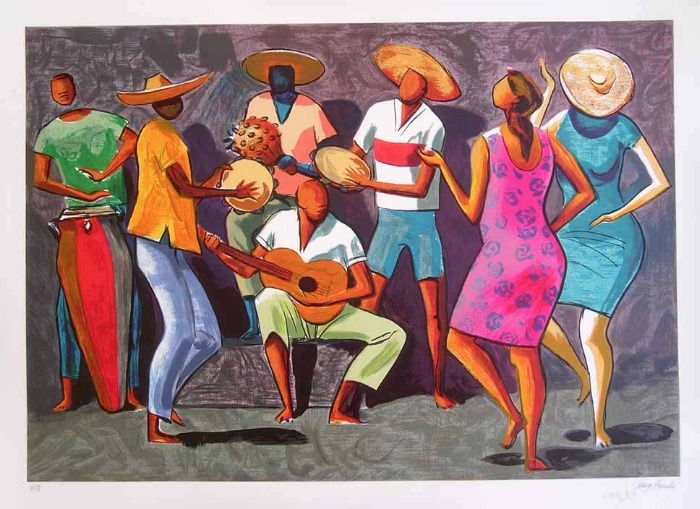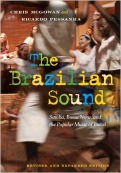In the late 19th Century, leading up to the abolition of slavery in Brazil in 1888, large contingents of people of African descent migrated south from Bahia State to the then capital of the country, Rio de Janeiro. There in the center of the City, Bahians established their own community — an area that came to be known as A Pequena África no Rio de Janeiro, or “Little Africa in Rio.” At the forefront of this community were black matriarchs known as tias, or “aunts,” who were leaders in the Afro-Brazilian religion of Candomblé, makers of sweets, and party hostesses who played an essential role in the development of the samba carioca (Rio de Janeiro samba). Tia Ciata (Hilária Batista de Almeida, 1854-1924), who migrated from Bahia to Rio in 1876 at the age of 22, became a legendary figure in whose home some of the early samba pioneers in Rio gathered and made music. The song “Pelo Telefone” (Donga/Mauro de Almeida), created at Tia Ciata's house, was the first song to be registered as a samba, in 1916.
Listen
Baiano — "Pelo Telefone" (1916)
Look

source
Praça Onze (Plaza 11), a meeting point in an area of downtown Rio known as A Pequena África (Little Africa), where a large and influential community of Afro-Bahian migrants lived in the late 19th and early 20th Centuries.

source
Portrait of a woman, Bahia, Brazil (1880)

source
Heitor dos Prazeres (1898-1966) was an early sambista and painter who grew up near Praça Onze and participated in the legendary samba gatherings at Tia Ciata's.

source
Roda de Samba (Samba Circle), a painting by Heitor dos Prazeres
Watch
Little Africa Tour in Rio de Janeiro
A cultural tour revealing what “Little Africa” looks like today. Notice the baiana selling the typical snack called acarajé (made with black-eyed peas and palm oil) and, of course, the samba gathering — both legacies of the area’s Afro-Bahian roots.
Read

Samba
A riveting account of the author’s experience living in the Mangueira favela (shantytown slum) and parading with the Mangueira Samba School in the late 1980s. Includes a chapter on samba’s early history in Rio.


The Brazilian Sound
One of the most comprehensive books on Brazilian popular music in English with an excellent chapter on samba.
Learn More
For Lifelong Learners
DISCUSSION Ideas
Discuss
• Listen to the Radio Focus audio clip near the top of this page. Talk about how the “Little Africa” community nurtured samba composers and musicians.
• Study the photograph of Praça Onze above. What do you imagine was the effect of its demolition on the residents of “Little Africa”?
In the 1930s, modernization work planned in the area around Rio included the demolition of Praça Onze to make way for the new Avenida Presidente Vargas. The demolition, which brought down over 500 buildings and displaced hundreds of local families, began in 1941.
• This urban renewal project was one of many post-slavery projects that drove poor Afro-Brazilian cariocas (Rio natives), along with migrants from rural areas, to the ever-expanding favelas that cover the hillsides that surround Rio. Share your memories of historic buildings or neighborhoods (or places that held fond memories for you) that were destroyed to make way for new construction. What was the effect of the renewal project on people who lived in or visited the site? Were there improvements made that mitigated any negative outcomes?
• Watch the Little Africa Tour in Rio de Janeiro video above. Try making some acarajé using this recipe. Dendê oil is palm oil. Enjoy this treat as you listen to some of the sounds of “Little Africa” at the links provided above.
For Students
TEACHING IDEAS
Discuss
• Have students listen to the Radio Focus audio clip near the top of this page and read the essay “Little Africa in Rio de Janeiro” above. Talk about how the “Little Africa” community nurtured samba composers and musicians. Then read the description of the destruction of Praça Onze just below. Have a group discussion about the pros and cons of massive urban renewal projects such as this one. [Addresses CCSS Reading Standard 1 and Speaking and Listening Standard 2.]
• Study the photograph of Praça Onze above. What do you imagine was the effect of its demolition on the residents of “Little Africa”?
In the 1930s, modernization work planned in the area around Rio included the demolition of Praça Onze to make way for the new Avenida Presidente Vargas. The demolition, which brought down over 500 buildings and displaced hundreds of local families, began in 1941.
Discover
• Sambistas composed music and lyrics to protest and mourn the destruction of Praça Onze. Below is one example. After reading and discussing the lyrics, invite students to write lyrics that honor a place that is important to them. [Addresses CCSS Reading Standards 6 and 7 and Speaking and Listening Standard 2.]
Praça Onze
by Herivelto Martins
They are going to get rid of Praça Onze
There won't be any more Samba Schools,
no there won't
The tamborim* cries
The entire hill cries
Favela,** Salgueiro**
Mangueira,** Estação Primeira***
Keep your pandeiros****, keep them
Because the Samba School will not parade
Goodbye, my Praça Onze, goodbye
We already know that you will disappear
Take with you our memory
But you will stay forever in our hearts
And one day a new Plaza we will have
And your past we will sing
*a small frame drum;
**shantytown slums;
***a reference to the Estação Primeira de Mangueira Samba School
****a pandeiro is a Brazilian tambourine
Translation provided by Philip Galinsky, Ph.D.
(Director, Samba New York!)
Share
• Have students view the Little Africa Tour in Rio de Janeiro video above. Challenge them to make note of the sensory experiences communicated in the video. Invite them to create a video tour of a location of their choosing that similarly captures sites, sounds, and flavors. Share the video on your school’s website or publish it on a social media site such as YouTube.[Addresses CCSS Speaking and Listening Standard 5.]